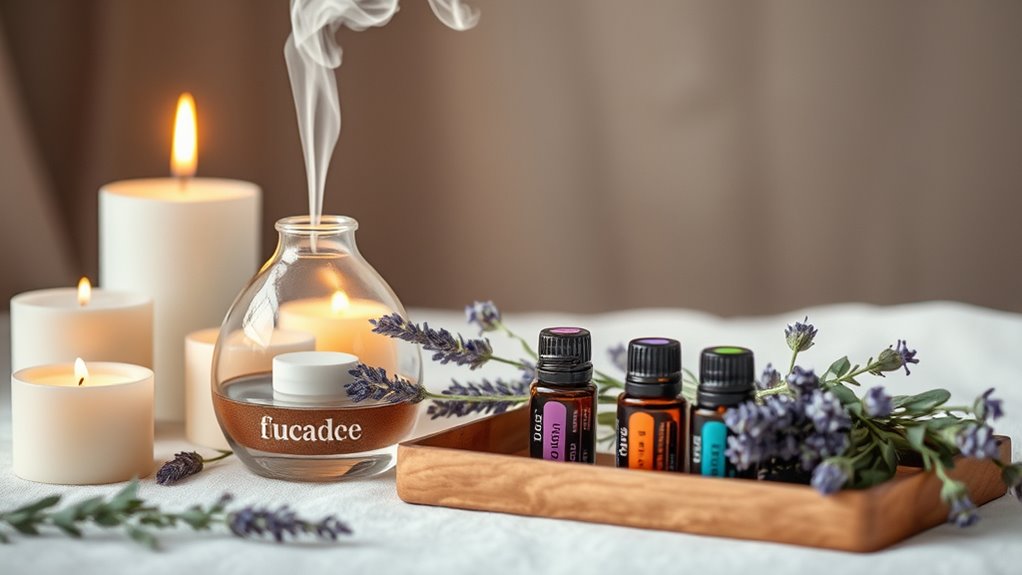Mindfulness & Well‑Being
Yoga Nidra: Guided Deep Relaxation for Mental Reset
Discover how Yoga Nidra’s guided relaxation can deepen your mental reset and transform your well-being—continue reading to unlock its full benefits.

Yoga Nidra is a simple, guided meditation that helps you achieve a deep state of relaxation while maintaining awareness. As you lie comfortably and follow calming instructions, you activate your parasympathetic nervous system, promoting rest and mental clarity. This practice helps you reset your nervous system, reduce stress, and build emotional resilience. With regular practice, you’ll notice greater calm and focus in your daily life—keep going to discover how it can transform your well-being.
Key Takeaways
- Yoga Nidra guides you into a deep, conscious relaxation, helping to reset the nervous system and reduce mental clutter.
- It enhances mindfulness and emotional balance by accessing the subconscious mind through guided visualization.
- Regular practice activates the parasympathetic nervous system, promoting rest, recovery, and resilience to stress.
- The technique requires no physical exertion, making it accessible for all experience levels to achieve mental clarity.
- Yoga Nidra serves as a powerful tool for stress relief, mental reset, and maintaining calmness in a fast-paced world.

Yoga Nidra, often called “yogic sleep,” is a powerful meditation technique that guides you into a deep state of relaxation while remaining aware. It’s a practice that allows you to access the subconscious mind, releasing built-up tension and mental clutter. When you engage in Yoga Nidra, you’re fundamentally combining elements of mindfulness meditation with proven stress reduction techniques to create a space for mental clarity and emotional balance. This method is accessible to everyone, regardless of experience level, because it doesn’t require physical exertion or complex postures. Instead, you simply lie down comfortably and follow the guided instructions, which lead you through a series of mental and physical awareness exercises.
During a typical session, you might be asked to focus on different parts of your body, breathe deeply, or visualize calming images. These steps serve to anchor your attention and deepen your relaxation. As you become more familiar with the practice, you’ll notice how it helps diminish the effects of stress, anxiety, and fatigue. The practice’s emphasis on mindfulness meditation allows you to stay present in the moment, observing thoughts or sensations without judgment. This non-reactive awareness enhances your ability to manage stress outside of your practice, making it a valuable stress reduction technique in today’s fast-paced world. Incorporating techniques like toilet flushing mechanisms can help in maintaining a calm environment, especially when practicing mindfulness at home.
Yoga Nidra encourages a state of conscious relaxation that bridges the gap between wakefulness and sleep. This unique state is particularly effective because it activates the parasympathetic nervous system, which promotes rest and recovery. As you settle into this deeply relaxed state, your mind becomes less reactive to external stressors, and your body resets from daily tensions. Over time, consistent practice can help rewire your stress response, making you more resilient when facing challenges. It’s like giving your nervous system a reset button, allowing you to approach life with calmer, clearer focus.
Frequently Asked Questions
Can Yoga Nidra Help With Chronic Pain Management?
Yes, Yoga Nidra can help manage chronic pain by reducing stress and improving mindfulness benefits. As you practice, you become more aware of pain perception and learn to dissociate emotional reactions from physical discomfort. This deep relaxation technique calms your nervous system, decreases tension, and fosters a sense of control, making pain feel less intense. Over time, it can be a valuable tool in your pain management routine.
How Often Should I Practice Yoga Nidra for Best Results?
You should practice yoga nidra daily or at least every few days. While it might seem like overdoing it, sticking to consistent practice provides the best results. Following frequency guidelines helps deepen relaxation and mental clarity. Remember, the irony is that by doing less, you often gain more. So, embrace regularity, and you’ll likely notice more profound benefits in stress relief and mental reset.
Is Prior Meditation Experience Necessary to Benefit From Yoga Nidra?
You don’t need a meditation background to benefit from Yoga Nidra. It’s designed to be accessible for beginners, making it easy to start regardless of your experience level. Even if you’re new to meditation, you’ll find it straightforward to relax deeply and reset your mind. With regular practice, you’ll notice improved mental clarity and stress relief, so no prior experience is necessary to enjoy its calming benefits.
Are There Any Contraindications or Health Risks Involved?
Yoga Nidra is generally safe, but you should consider safety precautions and health considerations. If you have severe health issues, like recent surgeries, mental health conditions, or are pregnant, consult your healthcare provider before practicing. Some may find certain positions uncomfortable or experience emotional release, so listen to your body. Always practice in a safe environment, avoid practicing while driving, and inform your instructor of any health concerns to guarantee a secure experience.
Can Yoga Nidra Improve Sleep Quality Long-Term?
Yoga Nidra acts like a gentle reset button for your mind, helping improve sleep quality long-term. It enhances your sleep hygiene by promoting relaxation and reducing stress, which can lead to deeper, more restorative sleep night after night. With consistent practice, you may find your sleep becomes more regular, and your stress levels drop, creating a positive cycle that benefits your overall well-being and sleep health over time.
Conclusion
As you gently drift back from this peaceful space, imagine yourself basking in warm sunlight, each breath easing tension away like waves softly lapping at the shore. Feel your mind refreshed, like a clear blue sky after a storm, ready to embrace the rest of your day with calm and clarity. Remember, this tranquil sanctuary is always within you—just a few deep breaths away, whenever you need a mental reset.
Mindfulness & Well‑Being
Mindful Eating: Savoring Meals to Improve Digestion
Just by practicing mindful eating, you can enhance digestion and enjoy your meals more fully—discover how to transform your eating habits today.

Practicing mindful eating helps you truly savor each bite, which can improve digestion and make meals more enjoyable. By slowing down and focusing on the flavors, textures, and smells, you become more aware of your body’s hunger and fullness cues. This intentional approach reduces overeating and emotional snacking. As you pay closer attention to your eating habits, you’ll develop a healthier relationship with food. Keep exploring to discover even more ways mindful eating can benefit your well-being.
Key Takeaways
- Savoring meals mindfully enhances digestion by encouraging slower eating and attentive chewing, facilitating better nutrient absorption.
- Paying attention to flavors, textures, and smells increases meal satisfaction and reduces overeating.
- Recognizing hunger and fullness cues prevents overeating, easing the digestive process.
- Mindful eating reduces emotional eating triggers, supporting a healthier digestion.
- Focusing on the present during meals promotes relaxation, which aids in optimal digestion.

Have you ever eaten a meal without really paying attention to what or how much you’re consuming? It’s common to mindlessly snack while watching TV or rush through lunch, barely noticing the flavors or textures. This habit can lead to overeating, digestion issues, and a disconnect from what your body truly needs. That’s where mindful eating comes in, encouraging you to slow down and become more aware of your body’s signals. One of the key practices is meal portioning, which involves intentionally serving yourself appropriate amounts and avoiding large, overwhelming portions. When you focus on meal portioning, you’re less likely to eat past fullness because you’re tuned into your hunger cues rather than external cues or emotional triggers. It’s especially helpful if you struggle with emotional awareness—recognizing whether you’re eating because of genuine hunger or emotional discomfort. Many people eat to soothe stress, boredom, or sadness, rather than because their body needs fuel. By practicing mindful eating, you learn to distinguish between physical hunger and emotional urges.
As you sit down to eat, take a moment to observe your surroundings and your feelings. Are you genuinely hungry, or are you eating out of habit or emotion? This awareness helps you create a healthier relationship with food, reducing impulsive eating driven by emotions. When you focus on your meal, notice the colors, smells, and textures of your food. Chew slowly, savor each bite, and pay attention to how the flavors develop. This not only enhances your enjoyment but also signals to your brain that you’re full, preventing overeating. With regular practice, your ability to recognize emotional cues improves, making it easier to choose different coping strategies when emotional hunger arises. You might decide to go for a walk, journal, or engage in a calming activity instead of turning to food. Incorporating attention to performance cookies can help you better understand your eating patterns and improve your mindful habits over time.
Mindful eating shifts your perspective from consuming mindlessly to engaging fully with your meal. It’s about being present in the moment, listening to your body, and respecting its signals. Over time, this approach can improve digestion, as your body is better prepared to break down food when you eat calmly and attentively. Plus, it fosters a healthier, more balanced relationship with food, helping you enjoy meals without guilt or distraction. By integrating meal portioning and emotional awareness into your eating habits, you create a more mindful, nourishing experience that benefits both your body and mind.
Frequently Asked Questions
Can Mindful Eating Help With Weight Loss?
Yes, mindful eating can help with weight loss. When you pay attention to your hunger cues and practice portion control, you’re less likely to overeat. Mindful snacking encourages you to choose healthier options and enjoy each bite, preventing mindless eating. By slowing down and savoring your meals, you become more aware of fullness, making it easier to maintain a healthy weight and develop better eating habits overall.
How Long Should Each Mindful Eating Session Last?
For mindful eating, aim for each session to last about 20 to 30 minutes. This allows you to focus on your meal, slow down your eating pace, and truly savor each bite. By extending your meal duration, you give your body time to recognize fullness signals, preventing overeating. Focus on eating slowly, paying attention to textures and flavors, and enjoy the process to enhance digestion and overall satisfaction.
Is Mindful Eating Suitable for Children?
Yes, mindful eating is suitable for children because it helps manage their appetite and promotes healthy mealtime routines. You can encourage your children to slow down, pay attention to flavors, and recognize when they’re full. By practicing these habits, you foster a positive relationship with food, improve digestion, and teach them valuable self-awareness skills. Incorporating mindful eating into their daily routine makes mealtimes more enjoyable and nourishing for your kids.
What Are Common Challenges in Practicing Mindful Eating?
You might find distraction reduction challenging when practicing mindful eating, especially with busy environments or electronic devices nearby. Maintaining sensory awareness can also be tough, as your mind may wander or focus less on flavors and textures. To overcome these, try creating a calm setting and consciously paying attention to each bite. These steps help you stay present, making mindful eating more effective and enjoyable.
Can Mindful Eating Reduce Emotional Eating Tendencies?
Think of mindful eating as a filter that catches emotional triggers before they turn into overeating. By staying present, you become more aware of your hunger cues and emotional triggers, making it easier to break habit formation around emotional eating. This practice helps you pause, reflect, and choose healthier responses, reducing the cycle of emotional eating tendencies. Over time, mindful eating rewires your habits for better emotional and physical well-being.
Conclusion
Remember, you are what you eat, so take the time to truly savor each bite. By practicing mindful eating, you’ll boost digestion, enjoy your meals more, and foster a healthier relationship with food. Slow down, listen to your body, and appreciate the flavors and textures. When you eat mindfully, you turn every meal into a nourishing experience. As the saying goes, “Haste makes waste”—so pause, breathe, and enjoy your food to reap its full benefits.
Mindfulness & Well‑Being
Nature Soundscapes: Using Audio to Reduce Stress
Lulling nature soundscapes can significantly reduce stress and enhance mental clarity, but discovering how they work reveals even greater benefits.

Listening to nature soundscapes is a simple, effective way to lower stress and improve mental clarity. These calming sounds, like bird calls, rustling leaves, and gentle winds, help you relax by transporting you to peaceful outdoor environments. They can block out distracting noise and encourage slow breathing, which reduces tension. If you want to discover how these audio environments can boost your well-being, there’s more to explore.
Key Takeaways
- Nature soundscapes promote relaxation by mimicking natural environments, helping to shift focus from stress to the present moment.
- Listening to bird calls, rustling leaves, and wind sounds can lower cortisol levels and reduce mental tension.
- Regular exposure to nature audio enhances sleep quality by signaling relaxation and blocking disruptive noises.
- Nature sounds encourage slow breathing and mindfulness, supporting stress management and overall mental health.
- Accessible through apps and devices, these soundscapes offer an easy, natural method for daily stress relief and relaxation.

Nature soundscapes offer a soothing escape from the noise of everyday life, immersing you in the natural symphony of the outdoors. When you listen to these sounds, you’re transported to tranquil environments where stress begins to melt away. One of the most enchanting elements of nature soundscapes is the gentle chorus of bird calls. These melodies, varying from cheerful chirps to melodious trills, create a calming backdrop that instantly relaxes your mind. As you tune in, you might imagine yourself wandering through a lush, green forest, where every bird adds a layer to the forest ambiance. The combination of bird calls and the rustling leaves forms a harmonious soundscape that reduces tension and promotes mental clarity.
Immerse yourself in tranquil nature soundscapes filled with cheerful bird calls and rustling leaves that calm the mind.
The forest ambiance is particularly effective in calming your nerves. The subtle sounds of wind whispering through trees, combined with the distant calls of birds, create a peaceful atmosphere that can help reset your mood. When you focus on these sounds, your brain shifts from stressful thoughts to the present moment, grounding your mind in the serenity of nature. This auditory experience not only distracts you from anxiety but also encourages slow, deep breathing, which further lowers your stress levels. Whether you’re at home, in the office, or on a walk, playing recordings of forest ambiance can serve as a natural stress reliever.
Listening to nature soundscapes with bird calls and forest ambiance can also improve your sleep quality. As these sounds mimic the natural environment, they signal your brain to relax and unwind, making it easier to fall asleep. The rhythmic patterns and gentle melodies act as a form of white noise, blocking out distracting sounds and creating a peaceful setting for rest. Over time, regularly immersing yourself in these soundscapes can enhance your overall sense of well-being, helping you manage stress more effectively.
You don’t need to be in a forest to enjoy these benefits. Many apps and online platforms offer high-quality recordings of bird calls and forest ambiance. With a pair of headphones or speakers, you can easily incorporate these calming sounds into your daily routine. Whether you need a moment of respite during a hectic day or a way to unwind before bed, nature soundscapes provide a simple, accessible method to reduce stress, reconnect with the natural world, and restore your sense of calm.
Additionally, these soundscapes can enhance mental health by fostering relaxation and mindfulness during stressful times.
Frequently Asked Questions
How Do Individual Preferences Influence the Effectiveness of Nature Sounds?
Your personal preferences greatly influence how effective nature sounds are for stress reduction. When you choose sounds that resonate with you, like rainforest or ocean waves, they create a calming effect. Sound customization allows you to tailor the audio to your liking, making it easier to relax. If you select sounds you enjoy, you’re more likely to experience the full benefits of stress relief, enhancing your overall well-being.
Can Nature Soundscapes Replace Traditional Stress Management Techniques?
Did you know that 65% of people report feeling calmer with nature soundscapes? While they can be a great addition to your stress reduction techniques, they shouldn’t replace traditional methods like exercise or therapy. Nature soundscapes provide quick relief and enhance relaxation, but for lasting stress management, you should combine them with proven techniques. Relying solely on soundscapes might not address deeper stress issues effectively.
Are There Specific Types of Nature Sounds More Effective for Certain Stress Levels?
You’ll find that bird chirping is especially effective if you’re mildly stressed, as it promotes calmness and alertness. Flowing water works best when stress levels are high, helping you relax and reset quickly. Depending on your mood, switching between these sounds can optimize stress relief. Try incorporating both into your routine for a tailored experience, and notice how each type influences your relaxation and overall well-being.
How Long Should One Listen to Nature Sounds for Optimal Stress Relief?
Imagine a gentle river carving through your worries; that’s what listening to nature sounds can do. For ideal exposure, aim for 20 to 30 minutes, allowing your mind to drift into calm waters. Listening duration matters—too short might leave stress lingering, while too long can lead to diminishing returns. Find your rhythm, and let these sounds be the steady current guiding you to tranquility.
Do Nature Soundscapes Have Any Long-Term Benefits on Mental Health?
Yes, nature soundscapes can positively impact your long-term mental health by promoting sustained relaxation. Regularly immersing yourself in these sounds helps reduce chronic stress, improve mood, and boost overall well-being. Over time, this practice can strengthen your resilience to mental health challenges. Incorporating nature sounds into your routine creates a calming environment, supporting ongoing mental health benefits and helping you maintain a balanced, relaxed state of mind.
Conclusion
Listening to nature soundscapes can considerably lower your stress levels and improve your overall well-being. In fact, studies show that just 20 minutes of exposure to natural sounds can reduce cortisol, the stress hormone, by up to 30%. So next time you’re feeling overwhelmed, try immersing yourself in the calming sounds of nature. It’s a simple, powerful way to recharge and find peace amidst your busy day. Your mind and body will thank you for it.
Mindfulness & Well‑Being
Aromatherapy & Essential Oils: Evidence for Well‑Being
Unlock the potential of aromatherapy and essential oils to enhance your well-being—discover how these natural scents may transform your health journey.

Aromatherapy and essential oils have scientific backing showing they can boost your well-being by promoting relaxation, reducing stress, and improving your mood. Studies suggest that certain oils like lavender may lower cortisol levels and ease anxiety, making them a natural complement to your health routine. When used safely and consistently, these scents can support your emotional and physical health. If you want to discover how specific oils may benefit you, keep exploring the options available.
Key Takeaways
- Scientific studies suggest essential oils like lavender may reduce cortisol levels and alleviate anxiety.
- Aromatherapy can promote relaxation, improve sleep quality, and support emotional well-being.
- Evidence indicates certain oils help boost mood and reduce stress when used properly.
- Proper dilution and safety guidelines are essential for effective and safe aromatherapy practice.
- Aromatherapy is a complementary approach that may enhance overall health but should not replace medical treatment.

Aromatherapy and essential oils have gained popularity as natural ways to promote well-being and balance. When you explore scent therapy, you’re tapping into a centuries-old practice that aims to support holistic health. Instead of relying solely on medication or conventional treatments, scent therapy involves using fragrant plant extracts to influence your physical, emotional, and mental state. This approach recognizes that health isn’t just about addressing symptoms but fostering overall harmony within your body and mind.
Discover the holistic power of scent therapy using natural essential oils to support your well-being and harmony.
As you incorporate essential oils into your routine, you’re engaging in a form of holistic health. These oils aren’t just about smelling nice; they’re believed to contain therapeutic properties that can help alleviate stress, improve sleep, boost mood, and even support immune function. For example, lavender is renowned for its calming effects, making it a popular choice for reducing anxiety and promoting restful sleep. Eucalyptus, on the other hand, is often used to clear respiratory pathways and boost energy levels. The key is understanding that scent therapy isn’t a one-size-fits-all solution—different oils can target specific needs, and their effects may vary from person to person.
You can use essential oils in various ways to support your well-being. Diffusing them in your living space allows the aroma to fill the air, creating a calming or invigorating environment. You might also add a few drops to a warm bath or create a personalized massage oil. When applied topically, it’s important to dilute essential oils with a carrier oil to prevent irritation. Regardless of the method, the goal is to harness the natural scent properties of these oils to influence your mood and physiological responses.
Scientific evidence supports some benefits of scent therapy, though it’s not a cure-all. Studies suggest that certain essential oils can reduce cortisol levels, ease symptoms of depression, or promote relaxation. Additionally, understanding the safe use of essential oils, including proper dilution guidelines, ensures a positive experience and minimizes risks. However, the effects are often subtle and can depend on individual preferences and sensitivities. It’s essential to approach aromatherapy as a complementary practice rather than a replacement for medical treatment. As you experiment with different oils, pay attention to how each one makes you feel and adjust accordingly.
In the end, incorporating essential oils into your daily routine can be a meaningful way to support your holistic health. By embracing scent therapy, you’re engaging your senses to enhance your emotional, mental, and physical well-being naturally. Always remember to use high-quality oils and consult with healthcare professionals if you have underlying health conditions or are pregnant. With mindful use, aromatherapy can become a gentle, effective tool for maintaining balance and promoting overall wellness.
Frequently Asked Questions
Can Aromatherapy Replace Conventional Medical Treatments?
Aromatherapy can’t replace conventional medical treatments, but it can serve as a helpful complementary therapy. You might find it enhances your overall well-being and supports holistic approaches to health. While it offers relaxation and stress relief, always consult your healthcare provider before relying solely on aromatherapy for serious conditions. Incorporating essential oils thoughtfully can contribute to your wellness plan without substituting proven medical care.
Are There Any Safety Concerns With Essential Oil Use?
Sure, using essential oils is perfectly safe—if you follow dilution guidelines and watch for skin sensitivity. Ignoring these precautions might turn your relaxing lavender into a fiery disaster or a rash-inducing nightmare. Always dilute oils properly and do a patch test to avoid allergic reactions. Remember, even natural substances can cause harm if misused, so stay cautious and informed to enjoy aromatherapy safely!
How Do I Choose the Right Essential Oil for Me?
You should choose an essential oil based on your personal preferences and scent selection. Start by exploring different fragrances to see which ones evoke positive feelings or relaxation. Consider your needs, like calming or energizing effects, and pick oils known for those benefits. Always test a small amount first to guarantee you don’t have sensitivities. Trust your instincts and select scents that resonate with you for a more enjoyable experience.
Can Aromatherapy Help With Specific Mental Health Issues?
Did you know that over 60% of people report using aromatherapy to manage stress? Yes, it can help with specific mental health issues by enhancing mindfulness benefits and supporting emotional regulation. Essential oils like lavender or chamomile may reduce anxiety and promote relaxation. While not a substitute for professional help, incorporating aromatherapy into your routine can complement other mental health strategies effectively.
What Is the Best Way to Store Essential Oils?
To maximize essential oil longevity, store them in dark glass bottles away from direct sunlight and heat. Keep caps tightly sealed to prevent oxidation and evaporation. Store oils in a cool, dry place, like a drawer or cupboard, to maintain their potency. Follow these storage tips, and your essential oils will stay fresh longer, ensuring you get the most benefit from their therapeutic properties whenever you use them.
Conclusion
So, next time you’re drowning in stress, just spritz some lavender, breathe in, and pretend it’s a miracle cure. Who needs science when you’ve got a scented bottle promising paradise? Maybe those essential oils are your new best friend—unless you’d rather face reality with a pinch of skepticism. Either way, remember: a whiff of wellness might just be your ticket to bliss… or at least a good sniff before the chaos resumes.
-

 Wish Notes1 year ago
Wish Notes1 year agoBest Caption to Wish Myself a Happy Birthday That Everyone Will Like!
-

 Wish Notes1 year ago
Wish Notes1 year agoThe Best Birthday Wishes to Make Your Uncle's Day Bright!
-

 Wish Notes1 year ago
Wish Notes1 year agoThe Sweetest Happy Birthday Wishes for Your Wife!
-

 Wish Notes1 year ago
Wish Notes1 year agoThe Best Happy Birthday Wish for Your Brother That Will Make Him Smile!
-

 Wish Notes1 year ago
Wish Notes1 year agoHeartwarming Birthday Messages for Mom in Spanish
-

 Wish Notes1 year ago
Wish Notes1 year agoThe Best Happy Birthday Wishes for Your Husband That Will Make His Day!
-

 Wish Notes1 year ago
Wish Notes1 year agoThe Ultimate Birthday Wishes to Celebrate Yourself!
-

 Wish Notes1 year ago
Wish Notes1 year agoThe Most Heartfelt Good Night Wishes Ever!





















